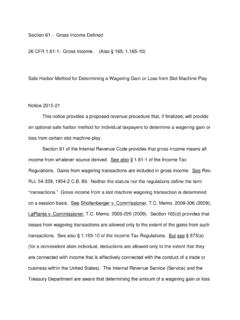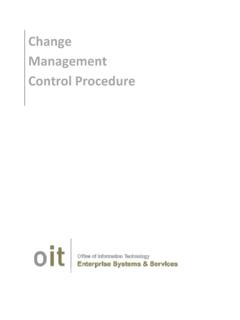Transcription of 26 CFR 601.204: Changes in accounting periods and methods ...
1 26 CFR : Changes in accounting periods and methods of accounting . (Also Part 1, 263A, 446, 447, 448, 460, 471, , , , , , ) Rev. Proc. 2022-9 SECTION 1. PURPOSE This revenue procedure modifies Rev. Proc. 2019-43, 2019-48 1107, as modified by Rev. Proc. 2021-34, 2021-35 337, to provide procedures under 446 of the Internal Revenue Code (Code) and (e) of the Income Tax Regulations to obtain automatic consent of the Commissioner of the Internal Revenue (Commissioner) to change methods of accounting to comply with the final regulations under 263A, 448, 460 and 471 of the Code issued on January 5, 2021 ( 9942). This revenue procedure also modifies Rev. Proc. 2018-40, 2018-34 320, to remove the option of netting the remaining portion of a 481(a) adjustment that resulted from a prior method change. This revenue procedure also provides procedures for taxpayers to revoke an election made under proposed (b)(2)(i)(B) for taxable years beginning on or after January 5, 2021, or in the case of taxpayer that early applies the final regulations, for taxable years in which the final regulations are applicable.
2 SECTION 2. BACKGROUND - 2 - .01 On December 22, 2017, section 13102 of Public Law 115-97, 131 Stat. 2054, 2113, commonly referred to as the Tax Cuts and Jobs Act (TCJA) amended 448 of the Code by increasing the gross receipts test amount for eligibility to use the cash receipts and disbursement method (cash method) to $25,000,000 (adjusted for inflation). It also amended 447 to incorporate by reference the gross receipts test of 448 and amended 263A, 460, and 471 by modifying the exemptions from the requirements to apply certain method of accounting rules for cost capitalization, long-term contracts, and inventories for eligible taxpayers. The amendments to 263A, 447, 448, and 471 generally apply to taxable years beginning after December 31, 2017. The amendments to 460 apply to contracts entered into after December 31, 2017, in taxable years ending after December 31, 2017.
3 For taxable years beginning in 2019, 2020 and 2021, the inflation-adjusted gross receipts test amount is $26,000,000. See Rev. Proc. 2018-57, 2018-49 827, Rev. Proc. 2019-44, 2019-47 1093, and Rev. Proc. 2020-45, 2020-46 1016, for the inflation-adjusted gross receipts test amount for taxable years beginning in 2019, 2020, and 2021, or their successor(s) for the inflation adjusted amount for taxable years beginning after 2021..02 On August 20, 2018, the Department of the Treasury (Treasury Department) and the Internal Revenue Service (IRS) published Rev. Proc. 2018-40, which provides administrative procedures for an eligible taxpayer to obtain the automatic consent of the Commissioner to change its methods of accounting to reflect the TCJA modifications to 263A, 448, 460, and 471. Rev. Proc. 2018-40 also requested comments for future - 3 - guidance regarding the implementation of the TCJA modifications to 263A, 448, 460, and 471.
4 03 On August 5, 2020, the Treasury Department and the IRS published a notice of proposed rulemaking (REG-132766-18) in the Federal Register (85 FR 47508), correction published in the Federal Register (85 FR 58307) on September 18, 2020, containing proposed regulations under 263A, 448, 460, and 471 (proposed regulations). In response to comments received on Rev. Proc. 2018-40, proposed (b)(2)(iii)(B) provided an election to use allocations made in the immediately preceding taxable year, instead of the current taxable year s allocations, when determining if more than 35 percent of losses of a venture are allocated to limited partners or limited entrepreneurs for purposes of the syndicate definition under proposed (b)(2)(i)(B). The election could be revoked only with the written consent of the Commissioner and could not be revoked earlier than the fifth taxable year following the first taxable year for which it was made, absent extraordinary circumstances.
5 The final regulations under (b)(2)(i)(B) modified the election by making it an irrevocable annual election..04 On January 5, 2021, the Treasury Department and the IRS issued final regulations under 263A, 448, 460 and 471 in the Federal Register (86 FR 254), correction published in the Federal Register (86 FR 32185) on June 17, 2021, to implement the statutory amendments made by section 13102 of the TCJA (final regulations). The final regulations under 263A, 448, and 471 are applicable for taxable years beginning on or after January 5, 2021, and the final regulations under - 4 - 460 are applicable for contracts entered into in taxable years beginning on or after January 5, 2021. However, a taxpayer may apply the final regulations for a taxable year beginning after December 31, 2017, and before January 5, 2021 (or, in the case of final regulations under 460, for contracts entered into after December 31, 2017, in a taxable year ending after December 31, 2017, and before January 5, 2021), provided that if the taxpayer applies any aspect of the final regulations under a particular Code provision, the taxpayer must follow all the applicable rules contained in the final regulations that relate to that Code provision for such taxable year and all subsequent taxable years, and must follow the administrative procedures for filing a change in method of accounting in accordance with (e)(3)(ii).
6 For example, a taxpayer that wants to early apply (j) to be exempt from capitalizing costs under section 263A must also early apply to determine whether it is eligible for the exemption under (j) and whether it is eligible to use the cash method under 448. Alternatively, a taxpayer may rely on the proposed regulations for a taxable year beginning after December 31, 2017, and before January 5, 2021, provided that if the taxpayer relies on any aspect of the proposed regulations under a particular Code provision, the taxpayer must follow all of the applicable rules contained in the proposed regulations that relate to that Code provision for such taxable year, and follow the administrative procedures for filing a change in method of accounting in accordance with (e)(3)(ii)..05 Except as otherwise provided by the Code or the regulations, 446(e) and (e)(2) require a taxpayer to secure the consent of the Commissioner before - 5 - changing a method of accounting for Federal income tax purposes.
7 Sections 263A(i)(3), 448(d)(7), 460(e)(2)(B) and 471(c)(4) of the Code provide that certain Changes in method of accounting related to the small business taxpayer exemptions are made with the consent of the Secretary. Nonetheless, a taxpayer still must follow the applicable administrative procedures to make such Changes . See, , Capital One Financial Corporation and Subsidiaries v. Commissioner of Internal Revenue, 130 147, 157 (2008)..06 The preamble to the final regulations indicates that the Treasury Department and the IRS intend to issue procedural guidance that specifies the Changes in method of accounting under the final regulations that are eligible for automatic consent, potentially including Changes in method of accounting that would otherwise be ineligible for automatic consent as a result of the prior 5-year change eligibility limitations in sections (1)(e) and (f) of Rev.
8 Proc. 2015-13, 2015-5 419. The Treasury Department and the IRS have determined that taxpayers that are optionally changing their methods of accounting are distinguishable from taxpayers that are required by the Code to change their methods of accounting (because they no longer qualify for the small business taxpayer exemptions) and taxpayers that were previously required by the Code to change their methods of accounting , but subsequently requalify for the small business taxpayer exemptions. Accordingly, section 3 of this revenue procedure contains automatic consent procedures with special terms and conditions for taxpayers that are required by the Code to change their methods of accounting and for taxpayers that were required by the Code to change their methods of accounting , but - 6 - subsequently requalify for the small business taxpayer exemptions. Section 3 also provides the applicable administrative procedures for taxpayers that are optionally changing their methods of accounting under the final regulations.
9 07 Section (e)(3)(ii) authorizes the Commissioner to prescribe administrative procedures that provide the terms and conditions necessary for a taxpayer to obtain consent to a change in method of accounting . Rev. Proc. 2015-13, as clarified and modified by Rev. Proc. 2015-33, 2015-24 1067, as modified by Rev. Proc. 2016-1, 2016-1 1, Rev. Proc. 2017-59, 2017-48 543, Rev. Proc. 2021-26, 2021-22 1163, and Rev. Proc. 2021-34 provides the general procedures by which a taxpayer may obtain automatic consent of the Commissioner to a change in method of accounting described in the List of Automatic Changes , as defined in section of Rev. Proc. 2015-13. Section (1) of Rev. Proc. 2015-13 sets forth the application procedures for timely filing a change in method of accounting under the automatic change procedures . Such procedural guidance provides that a taxpayer may not request, or otherwise make, a retroactive change in method of accounting on an amended federal income tax return, unless specifically authorized by the Commissioner or by statute.
10 See section of Rev. Proc. 2015-13. A taxpayer that chooses to early apply the final regulations under 263A, 448, and 471 to, or rely on the proposed regulations under 263A, 448, and 471 for, a taxable year beginning before January 5, 2021, or, in the case of the proposed and final regulations under 460, for contracts entered into after December 31, 2017, in a taxable year ending after December 31, 2017, and before January 5, 2021, must follow the rules for Changes in - 7 - method of accounting under 446, the accompanying regulations, and the applicable procedural guidance, as described above. Accordingly, such taxpayer cannot change its method(s) of accounting to early apply the final regulations or rely on the proposed regulations on an amended federal income tax return..08 As modified, Rev. Proc. 2019-43 contains the current List of Automatic Changes , which includes the modifications made by Rev.











